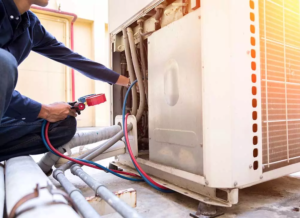Joe’s Plumbing industry consists of pipes, drains, fittings, valves, fixtures, and appliances that convey fluids. These fluids can be water or sewage.

Plumbing differs from process piping in that the former carries potable (drinking) water and waste, while the latter transports gases, chemicals, water, or other liquids during manufacturing processes.
The sanitary sewer service lateral is the run of pipe that connects your house to the city’s main sewer line. It conveys wastewater from your home’s sinks, tubs, toilets and other interior drains to the separate sanitary sewer system that carries it away to be treated at a waste management facility.
The property owner is responsible for maintaining the sanitary sewer service lateral and cleanouts, including their connection to the City sewer main line. This is different than in condominiums or homeowners’ associations, where the association typically oversees maintenance of the lower lateral from the home to the street.
A properly functioning lateral ensures your plumbing and sewer system is carrying away all waste in a safe and sanitary manner, without overflowing and backing up into the home’s living spaces or surrounding properties. A clogged or damaged lateral can lead to flooding, expensive damage to the home’s structure and environmental hazards.
In order to prevent lateral problems, there are some simple steps that can be taken. First and foremost, keep the lines clear of debris such as roots, rocks and other obstructions by having your lateral cleaned regularly by a licensed plumber. Secondly, avoid flushing anything but human waste and toilet paper. Putting non-toilet paper items down your toilets like rags, diapers and grease can lead to clogged pipes. Lastly, have your lateral tested for defects and make any necessary repairs.
The main issue that can occur with the sanitary sewer service lateral is failure due to age and other factors. Older pipes may experience deterioration, root infiltration, structural failures and broken connections. Newer pipes may also suffer from insufficient slope, cracks, faulty joints and other issues that can cause failure.
It is important to know that the city typically is not responsible for issues with the lateral, unless they directly caused the problem. Oftentimes, the city will repair a lower lateral when they are doing work on the main sewer line.
However, if there is an issue with the lower lateral, it will be the homeowner’s responsibility to handle all of the digging and other costs associated with fixing the line. Having your lateral inspected and repaired by an appropriately licensed plumbing contractor is the best way to protect your investment.
Pipe Leaks
A pipe leak is one of the most common plumbing problems. It can cause serious damage to your home or business if left unattended. It may also lead to mold growth, high water bills, and stains on your walls and ceilings.
If you think you have a pipe leak, there are several things you can do. First, try to determine if the leak is from a water supply or drain line. This will help narrow down the possible causes. If the leak is from a water supply pipe, you should turn off your main water valve to prevent further damage. Then, place a bucket or container under the leak to catch the water and minimize any further damage.
Another common reason for a pipe leak is corrosion. This happens when the copper pipes in your home are exposed to the elements, or to chemical cleaners used by household cleaning products. Corrosion can cause small holes in the pipes that are difficult to notice, but which will get worse over time if left unattended. If you have copper pipes, you should consider having them repainted or coated in plastic to protect them from corrosion.
Leaks can also happen when water pressure is too high for the pipes to handle. When this happens, the pipes can burst. This is most often seen in older homes or in areas where the pipes are exposed to a lot of heat, like near stoves and heaters.
It’s also important to keep in mind that pipe leaks can be caused by improper installation, wear and tear, or faulty hardware. For example, when a plumber connects a new fixture to an old pipe, they use a seal around the water connector that can break down or wear out over time. If you’re suspicious that you have a leaking pipe, a plumber can test it for you. They will put dye into the water and then run a test fixture such as a toilet or sink faucet. If the dye shows up in the fixture, you have a pipe leak.
In most cases, a pipe leak can be repaired fairly easily by a professional plumber. However, if you decide to try and fix the leak yourself, make sure to use a repair product that is suitable for the type of pipe you have, and the amount of water pressure it handles. It’s also a good idea to turn off the water supply before beginning any work on a leaking pipe.
Sewer Line Repairs
Sewer line repairs aren’t fun and certainly not cheap, but they’re necessary to keep your home’s plumbing running smoothly. Ignoring them can lead to costly damage down the road.
The good news is that you can help prevent sewer line problems by taking steps to avoid clogs and leaks. These include regularly having your sewer line snaked, using drain cleaning products that can reduce the intrusion of tree roots, and ensuring you’re not flushing items down the drain that aren’t meant for it (like grease or hair). Additionally, you should have your sewer lines hydro jeted at least every two years to clear out any debris that might have accumulated in the pipes.
Performing regular inspections of your sewer line is also important, especially in older homes. These inspections can detect early signs of clogs, leaks, and misalignments. They can also identify potential problem areas like saggy lining, which may cause water and sewage to seep out of the line and into your yard.
Inspecting your sewer line can be done in a variety of ways, including using a camera to view the interior of the pipes. The footage can help specialists pinpoint the location and severity of the issue. It can also reveal issues like invasive tree roots, corrosion, and other damage to your pipes that would have otherwise gone unnoticed.
Once the experts have identified the problem they can recommend a solution that suits your needs and budget. This could include a spot repair, a pipe replacement, or a full sewer line replacement.
A popular method for repairing a damaged sewer line is called pipe lining. This trenchless technique involves running an inflatable tube that’s coated in epoxy down the pipe. When it’s inflated, the epoxy sticks to the inside of the pipe, which fills any cracks or holes and restores the structural integrity of your sewer line. It’s a great option for homeowners who aren’t comfortable having their property excavated. However, it’s important to choose a qualified plumber who has experience with this method and knows the regulations in your area.
Sewer Line Replacement
If your sewer line has been compromised by extensive damage, a complete replacement may be necessary. After professional diagnosis, using methods like sewer camera inspections, specialists will recommend an appropriate solution to restore the function of your home plumbing system.
If you suspect your home’s sewer line is damaged, the first thing to do is contact an experienced plumber. A licensed plumber will have the technical training and access to specialized tools and repair materials that allow them to diagnose and fix the problem quickly, efficiently, and minimize property damage.
The most common cause of sewer line damage is tree roots. The roots of large, mature trees can penetrate and damage pipes over time, causing clogs that prevent waste from flowing properly. A professional plumber can inspect your sewer line for root intrusion and determine if a simple root removal or a more invasive pipe repair will be needed.
Another common problem with sewer lines is holes or collapsed sections of the pipe. These areas can be caused by tree roots, heavy ground movement, or just the natural wear and tear of decades of use. A trained technician will be able to use the results of the sewer camera inspection to identify and locate the problem area and determine whether a repair or a replacement is needed.
Replacing your sewer line is a big project that can be expensive and time consuming. During the process, you’ll need to clear out your front yard and any surrounding landscaping to allow the plumbers to get to your pipes. It’s important to talk with your contractor about how long they expect the project to take and to prepare for any unforeseen issues that could add time to the completion date.
Once the old sewer line has been removed and replaced, it’s important to have your new pipe properly sloped. Ideally, your pipe will have a positive slope that falls about 1/4” per foot. This helps ensure that wastewater flows away from your home and doesn’t back up into the house. If your sewer line has a “belly” or sag, it’s important to have this repaired right away to avoid future problems.

